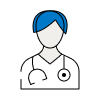Types of chemotherapy medicine
The type of chemotherapy medicine you have will depend on a number of factors including:
- the type of cancer
- where the cancer started
- what the cancer cells look like under a microscope
- whether the cancer has spread to other parts of your body
- your general health
Preparing for chemotherapy
An oncologist and a specialist nurse will usually oversee your chemotherapy. A pharmacist, physiotherapist, psychologist and dietitian may also be involved in your treatment.
Your doctor will explain why you're having chemotherapy and how to prepare for your treatment.
The length of your chemotherapy depends on the type of cancer you have, how much it has spread through your body, types of medicine used, severity of side-effects and how successful the treatment is.
You may have a number of tests before, during and after your chemotherapy. These may include:
- blood and urine tests – to check your blood count (the number of various blood cells in your blood) and how well your kidneys and liver are working
- blood pressure checks
- an ECG or echocardiogram – to see how well your heart is working
- lung function tests – to see how well your lungs are working
- an X-ray, CT scan or MRI scan
Your height and weight may also be checked to work out the right dose of chemotherapy for you.
You can take chemotherapy tablets or apply creams at home, whereas injections or infusions are usually given in hospital. However, some people may be able to have chemotherapy at home.
Your doctor will discuss with you what will happen before, during and after your chemotherapy. This is your opportunity to understand what will happen, and you can help yourself by preparing questions to ask about the risks, benefits and any alternatives to chemotherapy. This will help you to be informed, so you can give your consent for the treatment to go ahead, which you may be asked to do by signing a consent form.
During chemotherapy
Chemotherapy medicines can be given to you in different ways. Most commonly chemotherapy is given through a drip into your bloodstream (intravenous chemotherapy) or as tablets or capsules that you swallow.
Other ways of having chemotherapy medicines include:
- injections into the area around your spinal cord (intrathecal injection)
- injections into a muscle – usually your thigh or buttocks (intramuscular injection)
- injection under your skin (subcutaneous injection)
- injections into an affected body cavity such as your bladder (intracavity chemotherapy)
- creams for skin cancers
If you're having intravenous chemotherapy, medicines are given to you through a drip into your bloodstream and can be given through:
- a small tube in a vein in your arm or the back of your hand
- a thin tube inserted through the skin of your chest into a main vein near your heart (central line) – this can be left in for many months so medicines can be injected through it
- a thin tube placed into a vein in the crook of your arm and threaded through until it's in a vein near your heart (a PICC – peripherally inserted central catheter line) – this can also stay in place for many months
- a thin tube put into a vein ending in an opening (port) just under the skin on your arm or chest (called an implantable port or 'portcath') – medicines are passed via needles through the port
- an infusion pump – this is a portable pump that attaches to a PICC line or a central line and feeds in the correct dose of chemotherapy over a period of time
Chemotherapy will usually be given as several sessions. These may take between 30 minutes and a few hours at a time. You will then have a rest period, which could be anything from a few days to several weeks, to allow your body to recover. Treatment and rest periods make up a cycle. You may have a number of cycles depending on how well your cancer is responding to chemotherapy.
Your doctor will explain the treatment to you.
Recovery after chemotherapy
Your doctor or nurse will advise you on what to expect after chemotherapy and the side-effects you may have. Some people manage to continue with their lives as usual during and after chemotherapy. A small number of people even feel better as the symptoms of their cancer decrease.
However, for most people chemotherapy can have an impact on everyday life. In particular, tiredness often prevents people from working full-time or doing their usual levels of physical activity. Take things at your own pace and don't overdo it, particularly after you have just had treatment.
Risks of chemotherapy
There are some risks associated with chemotherapy. We have not included the chance of these happening as they are specific to you and differ for every person. Ask your doctor to explain how these risks apply to you.
Side-effectsSide-effects are the unwanted but mostly temporary effects of a successful treatment.
Chemotherapy doesn't only target cancer cells, but any cells that divide rapidly. This includes those in your bone marrow and skin, cells that produce hair and those lining your mouth and digestive system. Damage to these healthy cells may produce possible side-effects, including:
- tiredness
- feeling sick or vomiting
- diarrhoea
- thinning of hair or hair loss
- sore mouth, mouth ulcers or changes in your sense of taste
- numbness or 'pins and needles' in your hands and feet
- breathlessness
- skin changes – your skin may become dry or discoloured
- changes in hearing – some people get tinnitus (a ringing sound in your ears)
Side-effects vary greatly between the different types of chemotherapy and from person to person. Your doctor will discuss the possible side-effects of your specific treatment with you.
Many side-effects can be controlled using other medicines. For example, sickness can be reduced by taking antisickness medicines alongside your chemotherapy.
The side-effects of chemotherapy, such as sickness and diarrhoea, can make the contraceptive pill less effective. Women shouldn't try to become pregnant during treatment because the chemotherapy medicines may damage a developing baby.
Some chemotherapy medicines can affect your fertility. For some women it brings on early menopause. It's important that you discuss these risks with your doctor before you start the treatment. You may be offered the opportunity to store eggs, embryos, ovarian tissue or sperm for future fertility treatment.
Treatment with certain chemotherapy medicines can slightly increase your risk of developing a type of blood cancer called acute myeloid leukaemia in later life. Your risk of developing leukaemia years later will vary depending on how much chemotherapy you have. Your doctor will be able to give you more information about this.
Different chemotherapy medicines cause different side-effects, so it's important to discuss your specific treatment with your doctor.
Disclaimer
This information was published by Bupa Group's Health Content Team and has been reviewed by appropriate medical or clinical professionals. To the best of their knowledge the information is current and based on reputable sources of medical evidence, however Bupa (Asia) Limited makes no representation or warranty as to the completeness or accuracy of the Content.
The information on this page, and any information on third party websites referred to on this page, is provided as a guide only. It should not be relied upon as a substitute for professional medical advice, nor is it intended to be used for medical diagnosis or treatment. Bupa (Asia) Limited is not liable for any loss or damage you suffer arising out of the use of, or reliance on, the information.
Third party websites are not owned or controlled by Bupa and any individual may be able to access and post messages on them. Bupa is not responsible for the content or availability of these third party websites. Last updated August 2017.









